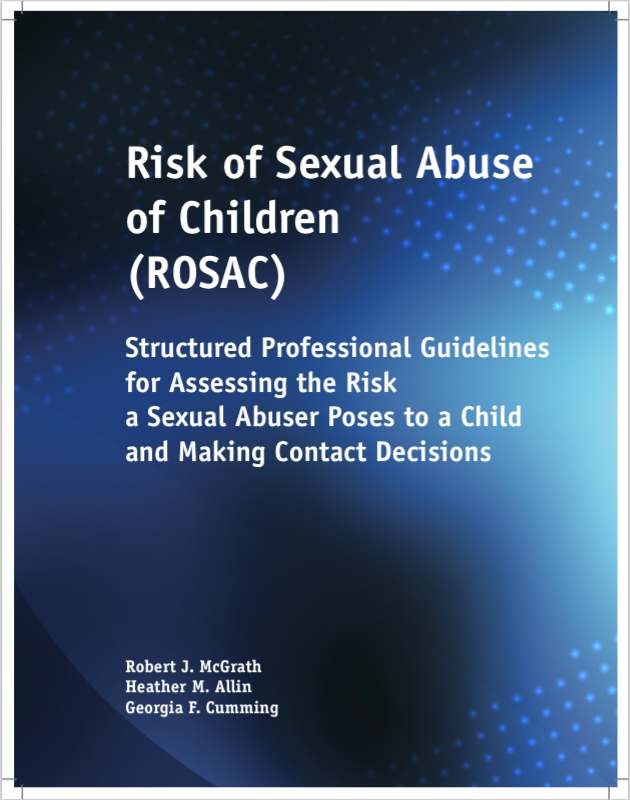Risk of Sexual Abuse of Children (ROSAC)
The ROSAC is a structured professional guide to help professionals assess the risk an adult male sexual abuser poses to a particular child and under what circumstances, if any, the abuser might safely be allowed contact with the child. It comprises 30 items, each coded on a 3-point scale. It is designed for use by child protection services professionals, probation and parole officers, mental health professionals, and victim advocates.
Typical situations in which the ROSAC may be helpful are:
- A child protective services (CPS) agency is investigating a report that a sexual abuser is now living with a family with children, and the agency must determine the risk of sexual harm to the child and develop an intervention plan.
- A probation officer must determine whether to grant a probationer’s request to live in a home with children. The probationer was previously convicted of committing a sexual offense.
- A mental health professional, CPS agency, probation department, and victim advocate are collaborating to determine whether to reunite a family where the father sexually abused one of his children.
The ROSAC Manual includes a step-by-step method for helping professionals make these important risk of sexual abuse decisions. The manual consists of worksheets for documenting the decision-making process. Individuals and organizations that purchase the ROSAC Manual may reprint these worksheets at no cost.
Manual
McGrath, R. J., Allin, H. M., & Cumming, G. F. (2015). Risk of Sexual Abuse of Children (ROSAC): Structured professional guidelines for assessing the risk a sexual abuser poses to a child and making child contact decisions. Brandon, VT: Safer Society Press. Available from Safer Society Press.
Coding and Worksheets
Copies of the ROSAC Coding Sheet and Data Collection Worksheets may be viewed here:
Recent ROSAC Training Sponsors
- Administrative Office of the U.S. Courts, Probation and Pretrial Services
- Arizona Association for the Treatment of Sexual Abuses
- Arkansas Association for the Treatment of Sexual Abusers
- Association for the Treatment of Sexual Abusers
- Center for Addiction and Mental Health, Sexual Behaviors Clinic, Toronto, Canada
- Family Services, Inc., Poughkeepsie, New York
- Global Institute for Forensic Research
- Idaho Association for the Treatment of Sexual Abusers
- Illinois Sex Offender Management Board
- Kanasa Department of Corrections
- Massachusetts Association for the Treatment of Sexual Abusers
- Michigan Association for the Treatment of Sexual Abusers
- Midwest Child Sexual Abuse Conference
- National Children's Advocacy Center Conference
- National Sexual Assault Conference
- North Dakota STAND and U.S. Probation and Pretrial Services
- Oregon Association for the Treatment of Sexual Abusers
- New York Association for the Treatment of Sexual Abusers
- New York State Child Abuse Prevention Conference
- Safer Society Foundation
- Vermont Department for Children and Families
- Vermont Developmental Disabilities Services Division
Workshop Description
Conducting Risk of Sexual Abuse of Children Assessments Using the ROSAC
Professionals in the child protective services, mental health, corrections, and child advocacy fields are commonly asked to assess the risk a sexual abuser poses to a particular child and under what circumstances, if any, the abuser might safely be allowed contact with the child. The Risk of Sexual Abuse of Children (ROSAC) uses a Structured Professional Judgment approach to conduct these assessments. The ROSAC is composed of 30 items that are linked to the risk of sexual abuse to children. Items are scored on a 3-point scale and are grouped into three categories, namely, considerations concerning the (1) abuser, (2) child at potential risk, and (3) primary caregiver. This one-day workshop will review the theory and research basis for the ROSAC and focus primarily on using case studies to assist participants in practicing how to score and use the instrument for making risk determinations and developing safety plans.
TRAINING
- For in-person or live webinar ROSAC training, contact Bob directly at robertmcgrath@robertmcgrath.us.
- For on-demand ROSAC training, go to Safer Society Foundation.
